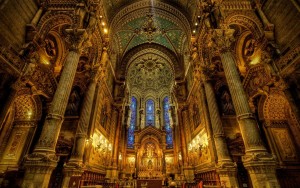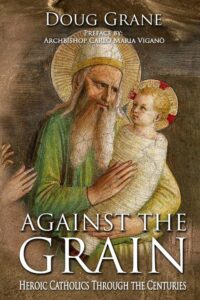We celebrate January 1, the start of a new year, as the Solemnity of Mary, Mother of God. But why is January 1 the start of a New Year, and why would we choose that day to celebrate Mary’s maternity? After all, didn’t her maternity begin with the conception of Christ, so shouldn’t her maternity be celebrated on March 25th, the Solemnity of the Annunciation? Or, if not then, than why not celebrate Mary’s maternity at Christmas, December 25th, with the birth of Christ? Of all the days in the year, why choose January 1? And why do Christians consider January 1 the start of a New Year?
Therein lies a tale…
The earliest recording of a new year celebration is believed to have been in Mesopotamia, circa 2000 B.C. That celebration — and many other ancient celebrations of the new year following it — were celebrated around the time of the vernal equinox, around March 20. Meanwhile, the ancient Egyptians, Phoenicians, and Persians began their new year with the autumnal equinox around September 20. And the ancient Greeks celebrated on the winter solstice, around December 20….
… According to tradition, during [the reign of the Roman king Numa Pompilius] (c. 715–673 AD), Numa revised the Roman republican calendar so that January replaced March as the first month. It was a fitting choice, since January was named after Janus, the Roman god of all beginnings; March celebrated Mars, the god of war. (Some sources claim that Numa also created the month of January.) However, there is evidence that January 1 was not made the official start of the Roman year until 153 BC….
… However, following the fall of Rome in the 5th century AD, many Christian countries altered the calendar so that it was more reflective of their religion, and March 25 (the Feast of the Annunciation) and December 25 (Christmas) became common New Year’s Days. … Pope Gregory XIII introduced a revised calendar in 1582. In addition to solving the issue with leap years, the Gregorian calendar restored January 1 as the start of the New Year.
Why did the Pope choose January 1 as the start of the new year instead of retaining March 25th or December 25th as its start? Well, follow the chain of reasoning.
The ancients believed that great men left the world on the anniversary of the day they entered the world, so as to complete the circle of divine providence. So, if a great man died on March 25th, it must be due to the fact that he was conceived on some earlier March 25th. Since Christians agreed that the day of the Crucifixion was March 25th in the Julian calendar, then Jesus must have been conceived on March 25th. And, of course, if Jesus was conceived on March 25th, then He must have been born exactly nine months later, on December 25th.
But, because Jesus was born a Jew, this likewise means He was circumcised and given the name Jesus exactly eight days later, on January 1, in fulfillment of Old Testament Law.* Now, in the most ancient times, the City of Rome celebrated January 1 as the Feast of Mary, Mother of God [Lumen Gentium, 66]. By the 7th century, the January 1st date was widely observed as a celebration of the Maternity of the Blessed Virgin Mary. Why that date?
In Hebrew tradition, the giving of a name is very strongly connected to the person’s soul, “It is said that parents receive a glimmer of divine inspiration when they give their child a Jewish name.” As Chabad.org notes, “Since Jewish identity is established maternally, it’s the mother that connects the soul to G‑d.” And notice the prayer associated with the naming of the male child at his circumcision:
Opposite the standing sandek, stands the one who will be honored with naming the child (some specifically honor the mohel, the ritual circumciser, with this blessing). A goblet of wine is poured, and the person who will name the baby recites the blessing on the wine, followed by the blessing of the naming of the child:
Blessed are You, L‑rd our G‑d, King of the universe, who sanctified the beloved one from the womb, set His statute in his flesh, and sealed his descendants with the sign of the holy Covenant. Therefore, as a reward of this [circumcision], the living G‑d, our Portion, our Rock, has ordained that the beloved of our flesh be saved from the abyss, for the sake of the Covenant which He has set in our flesh. Blessed are You L‑rd, who makes the Covenant.
He then names the child…
The prayers at circumcision echo the idea of the Incarnation, where God, sanctified in the womb, takes on flesh and seals His law, His covenant in His human body. Similarly, the ancient Christians recognized that the smallest drop of Christ’s blood is sufficient to save the whole world. Since the first drop of His blood is shed not at the Passion or Crucifixion, but at the Circumcision and Naming of Jesus, the circumcision is the beginning of mankind’s redemption.**
Thus, we can say that Mary, Mother of God, Mother of the Body of Christ, the Church, became fully a mother not at the conception or even the birth of Christ, but at the Circumcision, when the first drop of His blood was deliberately shed. It is the blood of Christ which empowers all the sacraments, so it is this first drop of blood which makes Mary the Mother of the Church. For this reason, the City of Rome and the wider ancient Christian world celebrated January 1 as the feast of Mary’s maternity.
Now, this connection between Mary’s maternity and the circumcision was so strong, and the first shedding of Christ’s blood so important, that by the 13th century, the Feast of the Circumcision of Christ had begun to replace the feast honoring Mary’s maternity. The celebration of her maternity was migrated to the first Sunday of May and, by 1914, it was moved to October 11. Meanwhile, from 1568 to 1960, January 1 was celebrated in the Roman Breviary as the Feast of the Circumcision.
However, this movement of the celebration of Mary’s motherhood to a day other than the Circumcision shattered the unity of the ancient understanding. In 1974, with the revision of the liturgical calendar after Vatican II, the Feast of the Circumcision was subsumed and rejoined, to again follow the ancient practice of dedicating January 1 to the Mother of God. But, this time, it would be celebrated as a universal feast.
By making January 1 the Solemnity of Mary, Mother of God, the day truly becomes a joint feast, in which Jesus, through the deliberate shedding of His blood, bestows on Mary her full, complete, divine motherhood. To this day, the Gospel reading at the Solemnity of Mary, Mother of God, is Luke’s description of the circumcision and naming of the child Jesus (Luke 2:16-21).
With the shedding of His blood, a new age began. Circumcision is the sign of covenant with God. At Jesus’ circumcision, God enters into covenant with Himself to save all mankind. A new age, a new promise, a new covenant, born of a woman, born under the old law, but completing that same old law with this new covenant, establishing in His own flesh and blood, and celebrating the fact that this flesh and blood was a gift from His mother, within whom He incarnated, creating and connecting His human soul to His own Godhead. Christians are grafted onto the root of salvation, which is the Jews, so the ancient Jewish understanding echoes: “it’s the mother that connects the soul to God.” They were nearly right. It is God that connects Mary to her full motherhood.
This is why January 1 is the beginning of a New Year, celebrated as the Solemnity of Mary, Mother of God. Christ’s first gift to humanity, Mary, our Mother, is given in the gift of a new age and a new year.
Notes
*Note: Similarly, Mary’s period of purification following the birth of Jesus was forty days, which would end on February 2, the traditional end of the Christmas season.
** Note: for those who argue that the birth and the shedding of placental blood was the first shedding of blood, keep in mind that the ancient Christians held that the birth of Christ was painless and without bloodshed. In ancient tradition, Jesus passed from Mary’s womb out into the world just as a ray of light passes out through a prism. Mary experienced the pain of birth not on Christmas, but rather during the Passion of Christ, when, as Pope Benedict XV said, she nearly died from the suffering of watching her Son beaten and crucified.
___
Originally published at The Fifth Column.
Photo: Anuja Mary Tilj, Unsplash / PD-US







1 thought on “Why January 1 is the Solemnity of Mary, Mother of God”
“the Roman king Numa Pompilius] (c. 715–673 AD), Numa revised the Roman republican (sic) calendar”
Rome overthrew its last king and first became a republic in 510 BC.